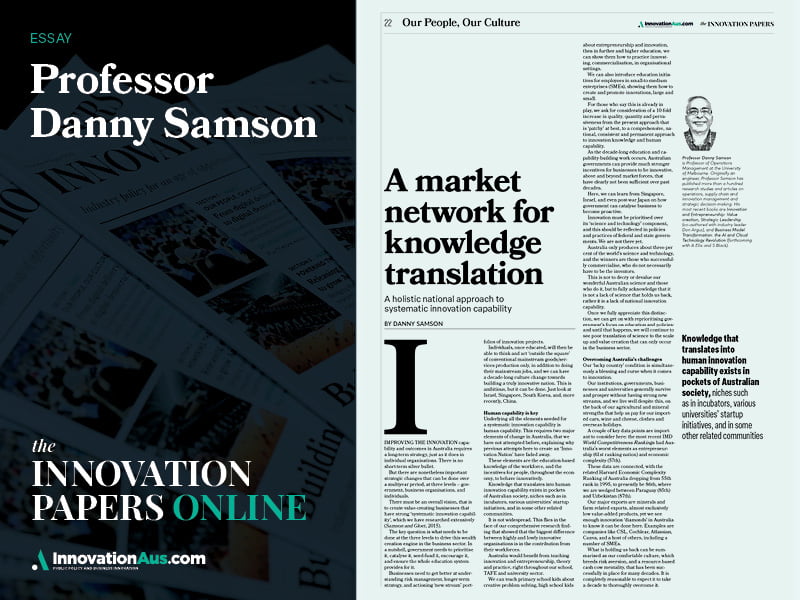Improving the innovation capability and outcomes in Australia requires a long-term strategy, just as it does in individual organisations. There is no short-term silver bullet.
But there are nonetheless important strategic changes that can be done over a multiyear period, at three levels – government, business organisations, and individuals.
There must be an overall vision, that is to create value-creating businesses that have strong ‘systematic innovation capability’, which we have researched extensively (Samson and Gloet, 2015).
The key question is what needs to be done at the three levels to drive this wealth creation engine in the business sector. In a nutshell, government needs to prioritise it, catalyse it, seed-fund it, encourage it, and ensure the whole education system provides for it.
Businesses need to get better at understanding risk management, longer-term strategy, and actioning ‘new stream’ portfolios of innovation projects.

Individuals, once educated, will then be able to think and act ‘outside the square’ of conventional mainstream goods/services production only, in addition to doing their mainstream jobs, and we can have a decade-long culture change towards building a truly innovative nation. This is ambitious, but it can be done. Just look at Israel, Singapore, South Korea, and, more recently, China.
Human capability is key
Underlying all the elements needed for a systematic innovation capability is human capability. This requires two major elements of change in Australia, that we have not attempted before, explaining why previous attempts here to create an ‘Innovation Nation’ have faded away.
These elements are the education-based knowledge of the workforce, and the incentives for people, throughout the economy, to behave innovatively.
Knowledge that translates into human innovation capability exists in pockets of Australian society, niches such as in incubators, various universities’ startup initiatives, and in some other related communities.
It is not widespread. This flies in the face of our comprehensive research finding that showed that the biggest difference between highly and lowly innovative organisations is in the contribution from their workforces.
Australia would benefit from teaching innovation and entrepreneurship, theory and practice, right throughout our school, TAFE and university sector.
We can teach primary school kids about creative problem solving, high school kids about entrepreneurship and innovation, then in further and higher education, we can show them how to practice innovating, commercialisation, in organisational settings.
We can also introduce education initiatives for employees in small-to-medium enterprises (SMEs), showing them how to create and promote innovations, large and small.
For those who say this is already in play, we ask for consideration of a 10-fold increase in quality, quantity and pervasiveness from the present approach that is ‘patchy’ at best, to a comprehensive, national, consistent and permanent approach to innovation knowledge and human capability.
As the decade-long education and capability-building work occurs, Australian governments can provide much stronger incentives for businesses to be innovative, above and beyond market forces, that have clearly not been sufficient over past decades.
Here, we can learn from Singapore, Israel, and even post-war Japan on how government can catalyse business to become proactive.
Innovation must be prioritised over its ‘science and technology’ component, and this should be reflected in policies and practices of federal and state governments. We are not there yet.
Australia only produces about three per cent of the world’s science and technology, and the winners are those who successfully commercialise, who do not necessarily have to be the inventors.
This is not to decry or devalue our wonderful Australian science and those who do it, but to fully acknowledge that it is not a lack of science that holds us back, rather it is a lack of national innovation capability.
Once we fully appreciate this distinction, we can get on with reprioritising government’s focus on education and policies: and until that happens, we will continue to see poor translation of science to the scale up and value creation that can only occur in the business sector.
Overcoming Australia’s challenges
Our ‘lucky country’ condition is simultaneously a blessing and curse when it comes to innovation.
Our institutions, governments, businesses and universities generally survive and prosper without having strong new streams, and we live well despite this, on the back of our agricultural and mineral strengths that help us pay for our imported cars, wine and cheese, clothes and overseas holidays.
A couple of key data points are important to consider here: the most recent IMD World Competitiveness Rankings had Australia’s worst elements as entrepreneurship (61st ranking nation) and economic complexity (57th).
These data are connected, with the related Harvard Economic Complexity Ranking of Australia dropping from 55th rank in 1995, to presently be 86th, where we are wedged between Paraguay (85th) and Uzbekistan (87th).
Our major exports are minerals and farm related exports, almost exclusively low value-added products, yet we see enough innovation ‘diamonds’ in Australia to know it can be done here. Examples are companies like CSL, Cochlear, Atlassian, Canva, and a host of others, including a number of SMEs.
What is holding us back can be summarised as our comfortable culture, which breeds risk aversion, and a resource-based cash cow mentality, that has been successfully in place for many decades. It is completely reasonable to expect it to take a decade to thoroughly overcome it.
Finding the solution
Adapting from what works for highly innovative businesses, to a national perspective, the following high-level plan, needing much further detail, would work if it was given a consistent decade of implementation:
- All elements of all three levels of government would prioritise innovation in policy statements, procurement contracts and grants, and embed it consistently in all activities.
- A comprehensive ‘innovation and entrepreneurship’ national curriculum would be developed and funded, from kindergarten through to university, with public financial support for deployment throughout the education system.
- Innovation successes would be championed nation-wide through a system of measures and reported accomplishments.
- The government would catalyse a strong form of clusters of companies, universities and research institutes to create spikes of excellence in sunrise industries, well beyond current growth centres, cooperative research centres and other programs.
- Incentives for innovators would include tax breaks as well as positive co-creative grants.
These proposed elements are the ‘full court press’ needed to wean Australia from our wonderful legacy of primary resources, cultural comfort, and hence innovation complacency.
While naysayers will defend the status quo and correctly say that some of these arrangements are already in place, the data says they are not pervasive or succeeding – and that they are not an integrated strategy at all.
We prescribe a 10-fold approach from that of the present, namely an order of magnitude upscaling of incentives, catalysts of open innovation, technological support, and educational effort from the present.
Sunrise industries such as critical minerals, renewable energies, quantum computing, and other technology intensive and high-value-added sectors such as medical research should be considered for prioritisation.
A national approach to open innovation means a renewed focus on accessing the 97 per cent of science that is not done in Australia, which can be harnessed, licensed or joint ventured for scale-up.
We propose that governments lead and catalyse such a plan because of the scale and scope that is required, because public institutions must be involved, and because incentives are needed.
The laissez-faire approach to innovation advancement in Australia has delivered poorly since World War II and needs the large kick forward that only government leadership can deliver. It needs a visionary approach. It can be done and is being done elsewhere.
The alternative to adopting such a positive vision and plan is depressing for Australia’s long-term prospects, as written by the Harvard group that did the economic complexity index analysis.
Tinkering with a less than holistic approach will not get it done, and if we continue to fiddle, we will be left to lament our national state of innovation underperformance in a decade from now, just as we have been doing for the past five decades.
A decade is a long time. But that is what Dr William Edwards Deming famously said is necessary to change culture. Deep systemic change can get it done in a decade, if there is change at all levels.
Otherwise we can continue to tinker as a nation and hope that the price of iron ore holds up forever.
Professor Danny Samson is Professor of Operations Management at the University of Melbourne. Originally an engineer, Professor Samson has published more than a hundred research studies and articles on operations, supply chain and innovation management and strategic decision-making. His most recent books are “Innovation and Entrepreneurship: Value creation, Strategic Leadership” (co-authored with industry leader Don Argus), and “Business Model Transformation: the AI and Cloud Technology Revolution” (forthcoming with A Ellis and S Black).
Footnotes:
A market network for knowledge translation
Samson, D., Gloet, M., Innovation and Entrepreneurship: Value Creation, Oxford University Press, 2015
Do you know more? Contact James Riley via Email.

